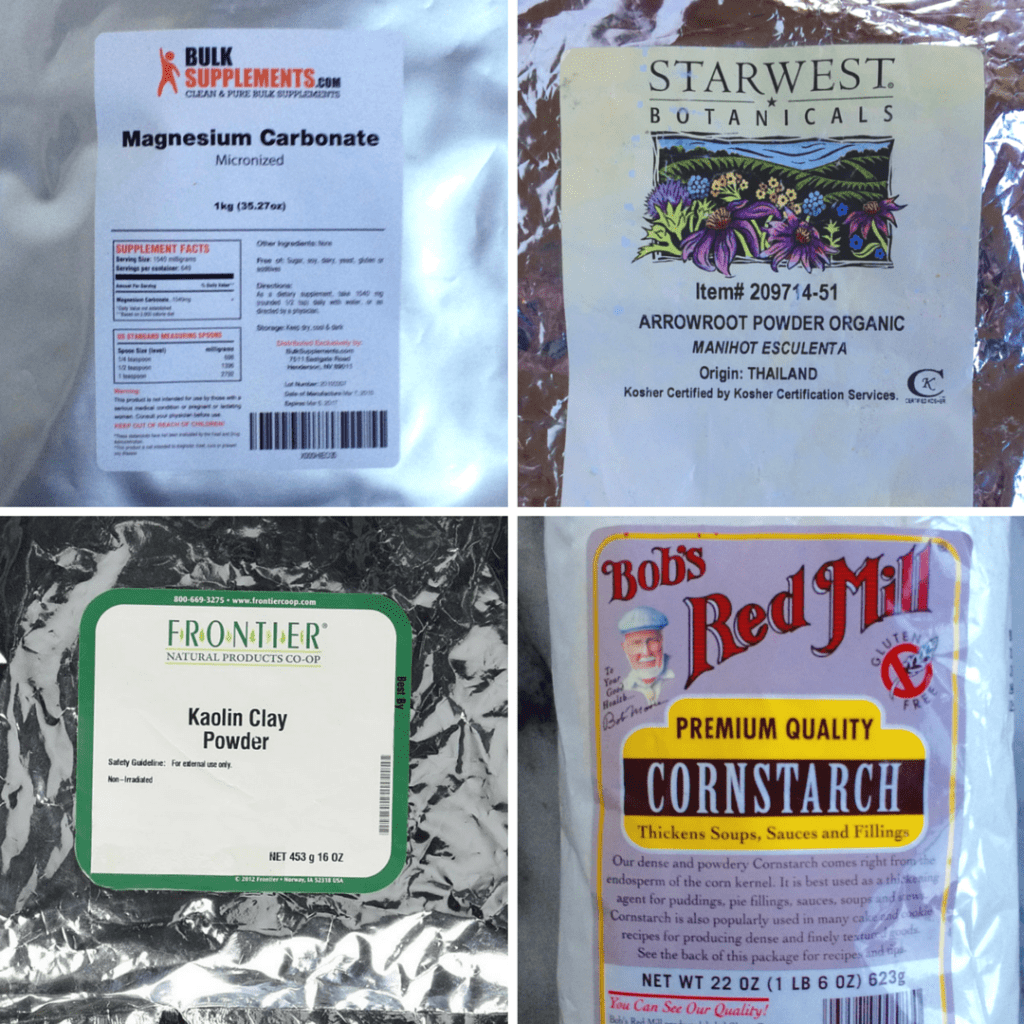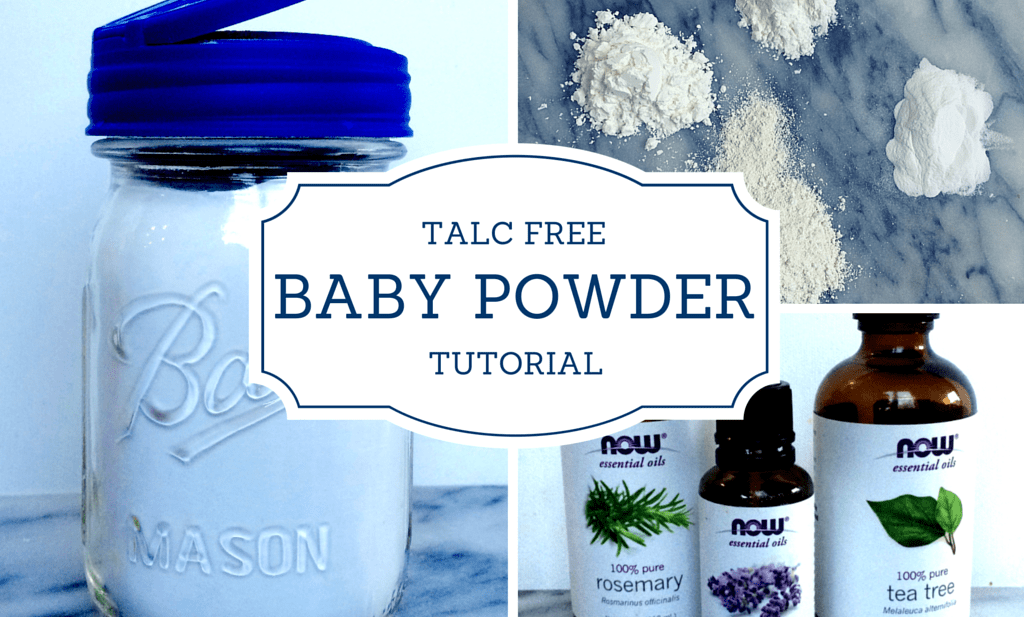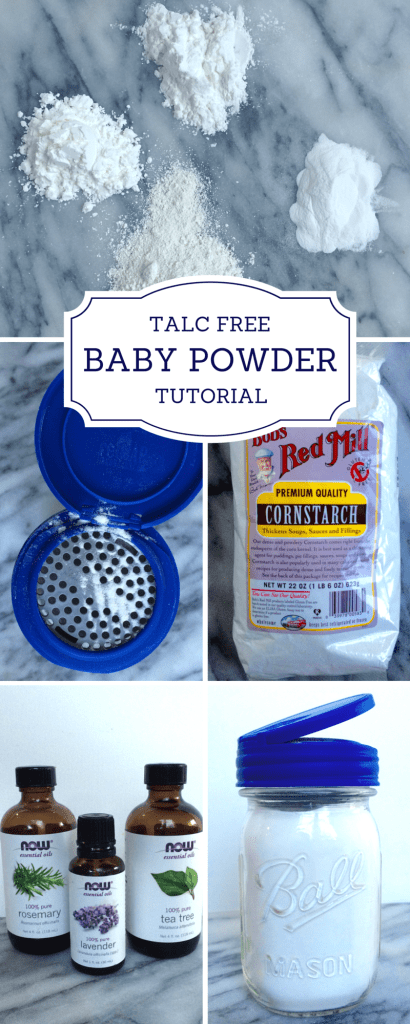My book publisher forwarded some interview questions to me from a British magazine a while back. One of the questions was, “Why would people want to make their own body care products instead of buying them in the shop?”
Three days after I returned my answer, Johnson & Johnson, the company behind some of the most recognizable brands in the world (Band-Aid, Neutrogena, Tylenol and many, many more) was found liable for fraud, negligence and conspiracy after their talc-based Baby Powder product was linked to an increased risk of ovarian cancer. (Reuters)
Johnson & Johnson was ordered to pay $72 million in damages to the family of a woman who used Johnson & Johnson baby powder for decades and died of ovarian cancer. 1,200 other lawsuits are in the pipeline, claiming a link between cancer and talcum powder. (Bloomberg)
So why might someone make their own body care products? Well at the moment, I can think of about 72 million reasons.
DIY Talc-Free Baby Powder Goals
The function of any baby powder is to keep moister areas of the body dry. So our goal is a powder that is moisture absorbing without being irritating or drying to the skin.
The powder should be gentle and soothing, and the texture should be light, fine and silky – not itchy or clumpy. Ingredients should be food-grade or otherwise accepted as very, very safe.
The Powdery Contenders

There are several powders that can help us meet our talc-free baby powder goals.
• Cornstarch – Food starch derived from common corn, used to thicken sauces and in baking. Very silky with good absorptive properties for both moisture and oil. Widely available. Can go on a bit clumpy when applied to skin on its own. Folks avoiding GMO products will want to be careful here. See note.
• Arrowroot Powder – Food starch derived from a South American tuber, used to create translucent sauces and glazes. Extremely light and silky in texture, and very gentle when used in body care products. See note.
• Kaolin Clay – A finely ground, off-white, cosmetic clay powder with excellent absorptive properties without being overly drying. Smooth and very gentle on skin.
• Magnesium Carbonate – A food-grade supplement taken in small quantities to increase magnesium levels in the body, this same mineral in block form is called Gym Chalk and is used by mountain climbers, weight lifters and gymnasts for its unrivaled sweat-absorbing ability. (It’s also cheaper as gym chalk than as a nutritional supplement.)
Can be very slightly gritty, with a texture like baking soda, and is alkaline, so plain Magnesium Carbonate powder might be irritating to sensitive skin or areas of the body. However, where moisture absorption without gumminess (think deodorant) is desirable, I think it’s a great ingredient.
• Baking Soda – Advantages: ubiquitous, inexpensive, odor absorbing. Disadvantages: gritty, alkaline and often irritating if left on the skin or used in large quantities. I use baking soda in my homemade deodorant, and in many products from toothpaste to body scrubs where a little abrasiveness is an asset.
The Essential Oil Helpers
You don’t need to add essential oils. They are totally optional. But let’s be honest -everything is more fun and better smelling with essential oils. And there’s a good chance you have a few basic essential oils around, anyway.
I’ve given some suggestions for specific essential oils below in the formulas, but you can modify these. I don’t recommend increasing the total number of drops of essential oil, but within a few limits, you can pick the brand and varieties of essential oil that appeal to you.
Do keep in mind that whatever essential oils you select should be skin-friendly and non-irritating.
If you aren’t sure, stay away from any essential oils that sounds like a citrus (orange, lemon, bergamot, etc.), a spice you might use during holiday baking (cinnamon, clove, etc.), or a type of gum (peppermint, spearmint). This goes double if you’ll be using your baby powder on actual babies.
No one ever went wrong with lavender.
The Custom-Blend Approach
There’s more than one way to blend DIY talc-free baby powder. Here are four options to suit a wide range of budgets, skin-types and moisture-absorption levels.
All formulations make about 1 total cup worth of powder and will last at least 6 months if kept away from moisture, though the essential oil scent may fade over time.
Simple and Cheap Body Powder
The advantages: no funny ingredients or essential oils – just inexpensive grocery staples you probably already have. The disadvantages: a nearly 100% cornstarch powder can be “clumpy” on the skin if it’s applied too heavily, and baking soda can be irritating to sensitive skin. But if simple and/or frugal is the priority, this is a great option.
- 3/4 cup Cornstarch
- 2 tbsp baking soda
Blend cornstarch and baking powder well in a small bowl. Store in an air-tight container.
To apply, sprinkle a small amount of powder onto your hand or directly onto your skin, then smooth the powder over your skin. Avoid the face and neck, and be cautious about other sensitive areas of the body. Avoid inhaling any body powder.
Super Gentle Baby Powder
With only the most gentle ingredients, this blend is what I’d recommend if you plan on using this baby powder on actual babies. Ask your pediatrician before using this – or any – powder on babies younger than 3 months.
- 3/4 cup Arrowroot powder
- 1/4 cup Kaolin Clay
- Up to 10 drops Calendula, Lavender or Chamomile essential oil (optional)
Blend arrowroot and kaolin clay well in a small bowl. Add essential oils, if using, and blend well to distribute the essential oils. Store in an air-tight container.
To use, apply, sprinkle a small amount of baby powder onto your hand away from baby’s face, so baby doesn’t inhale any of the powder. Gently apply the powder from your hand to baby’s body, avoiding baby’s face.
All-Purpose, All-Over Body Powder
Gentle enough for adults to use all over as a body powder. The essential oils recommended here remind me of a more “traditional” feminine baby powder smell; if you prefer a more gender-neutral scent, try the essential oil options recommended in the Super Dry Moisture Absorbing Powder, below.
- 3/4 cup Arrowroot powder (substitute all or part cornstarch if desired)
- 1/4 cup Kaolin Clay
- 1 tbsp. Magnesium Carbonate powder (sub Baking Soda if desired)
- 10 drops Lavender essential oil (optional)
- 5 drops Ylang Ylang essential oil (optional)
- 5 drops Rosewood essential oil (optional)
Blend arrowroot, kaolin clay and magnesium carbonate well in a small bowl. Add essential oils, if using, and blend well to distribute the essential oils. Store in an air-tight container.
To apply, sprinkle a small amount of powder onto your hand or directly onto your skin, then smooth the powder over your skin. Avoid the face and neck, and be cautious about other sensitive areas of the body. Avoid inhaling any body powder.
Super Dry Moisture Absorbing Powder
This is moisture absorbing enough to be used as a light deodorant powder, and has tea tree oil for added antibacterial stink-fighting. Smooth it on underarms, back of knees, feet – any place that tends to get sweaty. Just use good judgement before powdering up your more sensitive areas – do a small patch test to ensure this powder won’t irritate your skin.
- 1/2 cup Arrowroot powder (substitute all or part cornstarch if desired)
- 1/4 cup Kaolin Clay
- 1/4 cup Magnesium Carbonate powder (sub Baking Soda if desired)
- 8 drops Lavender Essential Oil (optional)
- 8 drops Tea Tree Essential Oil (optional)
- 5 drops Rosemary Essential Oil (optional)
Blend arrowroot, kaolin clay and magnesium carbonate well in a small bowl. Add essential oils, if using, and blend well to distribute the essential oils. Store in an air-tight container.
To apply, sprinkle a small amount of powder onto your hand or directly onto your skin, then smooth the powder over your skin. Avoid the face and neck, and be cautious about other sensitive areas of the body. Avoid inhaling any body powder.
Products Used
[wonderplugin_gridgallery id=1]
We’re worried about Baby Powder? Really?
From what I can tell, the science is still out on what degree of risk talc-based body powder poses. As you would expect, Johnson & Johnson says cosmetic talc is well established as safe.
Some studies show that talc-based baby powder increases the risk of ovarian cancer by about a third – some studies show tissue inflammation but no overall increase in total cancer risk. (Huffington Post)
A 1999 study published in the Journal of the National Cancer Institute suggests talc use doesn’t increase additional ovarian cancer risk overall, but does modestly increase the risk of invasive and serous ovarian cancer.
Long term use and application of baby powder on the…uh…more sensitive parts of the body, seem tied to increased cancer risk. So if you regularly powder your junk with talc-based powder, you might wanna stop.
That said, while we don’t want to take unnecessary risks with our health, we also don’t want to make ourselves sick with worry about stuff like this. You do things every day that are far more risky than using baby powder. So, you know, perspective is good.
Pin Me Mama Like A Wagon Wheel
And rock me mama like a southbound train. This song is on in the background as I write this, it’s super catchy. But back to our post…the internet is a big place. Here’s a thing you can pin so you can find this tutorial later:
117


Whenever I’ve used a cornstarch based powder I get skin infections. I think the starch actually FEEDS the bacteria.
Could be; could also be the powder is disrupting the acid mantle of your skin. In any event, if body powders don’t agree with your skin I’d continue to avoid them in your situation.
I’m seconding the concern about starches as body powders. As a nurse, I know that starches do feed yeasts that can thrive on moist skin: along any sweaty crease like the groin, under breasts, under yer butt cheeks, etc. Hospitals once used talc, then starch-based powders, now mostly neither. I’m not being a nay-sayer. Just offering a word of caution. If ya get yeasty, maybe don’t put starch there. Can’t speak to powder combos with baking soda or whatever though.
Erica, you are the best. I have a body dusting powder that I like, but don’t love the fragrance that comes with it. It’s a “fragrance”, not an essential oil. I did a quick search of the ingredients, and low and behold, they are essentially working with the same stuff here. With a couple of tweaks, I bet I can replicate it. Happy day!
I’m sure you can! And then you can scent however you like. 🙂
I only ever use talc to soak up moisture before waxing body hair (otherwise, sugar wax melts against the skin JUST enough to tug painfully instead of ripping out). However, the smell of ‘baby powder’ gives me a headache. Thanks for the arrowroot suggestion – I’ve got some in my pantry, I don’t know why it hadn’t occured to me to use that instead!
Thank you for the information and all the formulation options. This would be a really useful and cool baby shower gift! I think Imma need to order some of these goodies.
So have you used your formulation on a serious sweat day? Like heavy gardening in the heat? I take a medication that increases sweating. It’s like living a perpetual hot flash. Needless to say powder is a friend, but I’d hate to be a clumpy, gummy mess. I want wicking clothing embedded with powder, can you develop that next?
( I found your word usage regarding genitals particularly funny up until you used junk. Then I was like, oh there’s Erica.)
Erica, I was very happy to see that you noted that the science on a talc/ ovarian cancer risk is inconclusive at best. It might be nice to move it closer to the start of this article. It’s important, because “evidence based science” is increasingly getting kicked to the curb and that’s a bad thing (don’t vaccinate your kids because one disproved study said they were linked and now people have died from measles). That said, J &J started making cornstarch baby powder years ago, it’s what we use.
My baby has very sensitive skin and prone to allergy. I don’t know if I can use this.
Where do you find these containers and lids??
Where can I purchase the blue top for the mason jar?
I’ve been looking for one as well! Where did you get that lid for the ball Jar, I swear I’m going crazy, I’ve been looking for one all over the internet!!
Finally found them on amazon (DUH)
https://www.amazon.com/dp/B01IIXK70S/ref=twister_B01JMCH0AO?_encoding=UTF8&psc=1